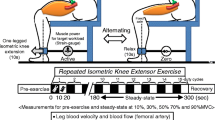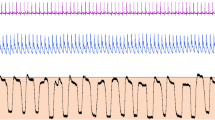Summary
The aim of the present paper was to study the development of fatigue during isometric intermittent handgrip exercise. Using a handgrip dynamometer, four combinations of contraction-relaxation periods were studied (10+10, 10+5, 10+2s and continuous contraction) at three contraction intensities (10, 25 and 40% maximum voluntary contraction, MVC). Local blood flow (BF) in the forearm (venous occlusion plethysmography) was followed before, during and after the exercise period. Electromyography (EMG) (frequency analysis) and the perceived effort and pain were recorded during the exercise period. Forearm BF is insufficient even at isometric contractions of low intensity (10% MVC). The results indicate that vasodilating metabolites play an active role for BF in low-intensity isometric contractions. It is shown that maximal BF in the forearm during relaxation periods (25–30 ml min−1 · 100 ml−1) is already reached at 25% MVC. Only intermittent exercise at 10% MVC and (10+5s) and (10+10s) at 25% MVC was considered acceptable with regard to local fatigue, which was defined as a switch of local BF to the post-exercise period, a decrease in the number of zero-crossings (EMG) and marked increases in subjective ratings.
Similar content being viewed by others
References
Barcroft H, Millen JLE (1939) The bloodflow through muscle during sustained contraction. J Physiol (Lond) 97:17–31
Björksten M, Jonsson B (1977) Endurance limit of force in longterm intermittent static contractions. Scand J Work Environ Health 3:23–27
Clarke R (1958) The duration of sustained contractions of the human forearm at different muscle temperatures. J Physiol (Lond) 143:454–473
Detry JM, Brengelman GL, Rowell LB, Wyss C (1972) Skin and muscle components of forearm blood flow in directly heated resting man. J Appl Physiol 32:506–511
Dimberg L (1987) The prevalence and causation of tennis elbow (lateral humeral epicondylitis) in a population of workers in an engineering industry. Ergonomics 30:573–580
Edholm OG, Fox RH, MacPherson RK (1956) The effect of body heating on the circulation in skin and muscle. J Physiol (Lond) 134:612–619
Furchgott RF (1955) Pharmacology of vascular smooth muscle. Pharmacol Rev 7:183–265
Hagberg M (1981) Muscular endurance and surface electromyogram in isometric and dynamic exercise. J Appl Physiol Respir Environ Exercise Physiol 51 (1):1–7
Hägg G (1981) Electromyographic fatigue analysis based on the number of zero crossings. Pflügers Arch 391:78–80
Humphreys PW, Lind AR (1963) The bloodflow through active and inactive muscles of the forearm during sustained handgrip contractions. J Physiol (Lond) 166:120–135
Jonsson B (1984) Muscular fatigue and endurance basic research and ergonomic applications. In: Kumamoto M (Ed) Neural and mechanical control of movement. Yamguchi Shoten, Kyoto, pp 64–76
Kilbom Å (1976) Circulatory adaption during static muscular contractions. A review. Scand J Work Environ Health 2:1–13
Kilbom Å, Persson J (1981) Circulatory response to static muscle contractions in three different muscle groups. Clin Physiol 1:215–225
Kilbom Å, Wennmalm Å (1976) Endogenous prostaglandins as local regulators of blood flow in man: effect of indomethacin on reactive and functional hyperaemia. J Physiol (Lond) 257:109–121
Kilbom Å, Gamberale F, Persson J, Annwall G (1983) Physiological and psychological indices of fatigue during static contractions. Eur J Appl Physiol 50:179–193
Kurppa K, Waris P, Rokkanen P (1979) Peritendinitis and tenosynovitis. A review. Scand J Work Environ Health 5 [Suppl 3]:19–24
Lind AR, McNicol GW (1967) Circulatory responses to sustained handgrip contractions performed during other exercise, both rhythmic and static. J Physiol (Lond) 192:595–607
Lindhard J (1920) Untersuchungen iffier statische Muskelarbeit. Scand Arch Physiol 4:145–195
Luopajärvi T, Kuorinka I, Virolainen M, Holmberg M (1979) Prevalence of tenosynovitis and other injuries of the upper extremities in repetitive Work. Scan J Work Environ Health 5 [Suppl 3]:48–55
Milerad E, Kilbom A (1985) Physiological and electromyographic response to repetitive hand-grip exercise. Clin Physiol 5 [Suppl 4]:134
Mundale M (1970) The relationship of intermittent isometric exercise to fatigue of hand grip. Arch Phys Med Rehabil 51:532–539
Richardson D (1981) Blood flow response of human calf muscles to static contractions at various percentages of MVC. J Appl Physiol Respir Environ Exerc Physiol 51:929–933
Rohmert W (1973) Problems in determining rest allowances. I. Use of modern methods to evaluate stress and strain in static muscular work. Appl Ergon 4.2:91–95
Sadamoto T, Bonde-Petersen F, Suzuki Y (1983) Skeletal muscle tension, flow, pressure, and EMG during sustained isometric contractions in humans. Eur J Appl Physiol 51:395–408
Sato H (1984) Endurance time and fatigue in static contractions. J Hum Ergol 13:147–154
Silverstein BA, Fine L, Armstrong T (1987) Occupational factors and carpal tunnel syndrome. Am J Med 11:343–358
Sinoway L, Shenberger J, Wilson J, McLaughlin D, Musch T, Zelis R (1987) A 30-day forearm work protocol increases maximal forearm bloodflow. J Appl Physiol 62:1063–1067
Sjögaard G, Savard G, Juel C (1988) Muscle BF during isometric activity and its relation to muscle fatigue. Eur J Appl Physiol 57:327–335
Taylor WF, Johnson JM, Kosiba WA, Kwan CM (1989) Cutaneous vascular response to isometric handgrip exercise. J Appl Physiol 66 (4):1586–1592
Vanhoutte PM, Shepherd T (1973) Venous relaxation caused by acetylcholine acting on the sympathetic nerves. Circ Res 32:259–267
Williams CA, Lind AR (1979) Measurement of forearm blood flow by venous occlusion plethysmography: influence of hand blood flow during sustained and intermittent isometric exercise. Eur J Appl Physiol 42:141–149
Williams CA, Mudd JG, Lind AR (1978) The forearm bloodflow during intermittent hand-grip isometric exercise. Circ Res 48 [Suppl 1]:110–117
Whitney RJ (1953) The measurement of volume changes in human limbs. J Physiol (Lond) 121:1–27
Author information
Authors and Affiliations
Rights and permissions
About this article
Cite this article
Byström, S.E.G., Kilbom, Å. Physiological response in the forearm during and after isometric intermittent handgrip. Europ. J. Appl. Physiol. 60, 457–466 (1990). https://doi.org/10.1007/BF00705037
Accepted:
Issue Date:
DOI: https://doi.org/10.1007/BF00705037




